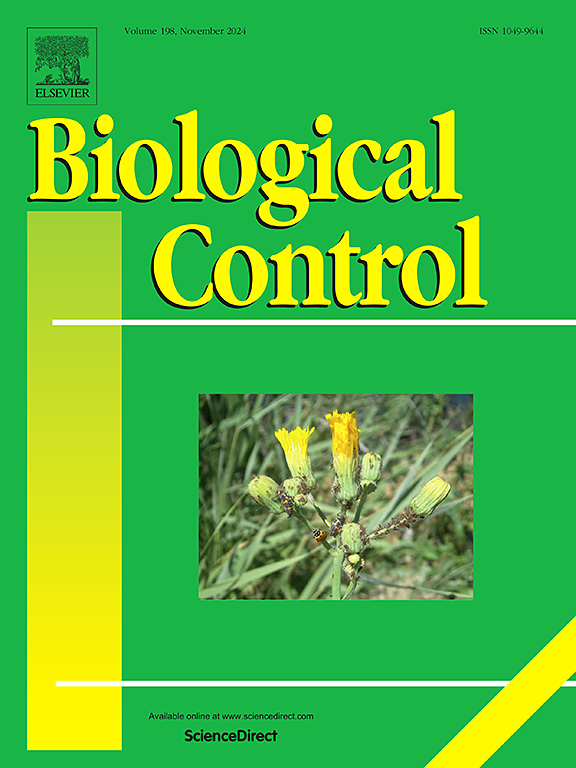The characterization and antifungal activities of two new Trichoderma antagonistic fungi against four apple disease pathogens
IF 3.7
2区 农林科学
Q2 BIOTECHNOLOGY & APPLIED MICROBIOLOGY
引用次数: 0
Abstract
Trichoderma is widely utilized in the biological control of plant diseases. In this study, two antagonistic fungi were isolated from cadavers of Spodoptera litura and Mythimna separata, and were identified as Trichoderma afroharzianum and Trichoderma asperelloides. The mycelia of T. afroharzianum grew fastest on the PSA medium under all light conditions, with soluble starch and peptone serving as the optimal carbon and nitrogen sources, respectively. The optimal pH was 6.0 and the lethal temperature was 57°C. The mycelia of T. asperelloides grew fastest on the PDA medium under all light conditions, with maltose and peptone as the optimal carbon and nitrogen sources, respectively. The optimal pH was 5.0 and the lethal temperature was 58°C. The two strains demonstrated antifungal activity against four apple disease pathogens: Alternaria mali, Collectotrichum gloeosporioides, Botryosphaeria dothidea, and Valsa mali. Antagonistic culture results showed that T. afroharzianum achieved an inhibition percentage exceeding 55 % against all four pathogens, while T. asperelloides exhibited the highest antifungal activity against B. dothidea (67.66 %). The mechanisms for controlling apple pathogens were investigated by measuring the activities of Poly Galacturonase (PG) and β-glucosidase (β-GC). In B. dothidea, the activities of PG and β-GC decreased by 58.92 % and 79.54 % when treated with T. afroharzianum culture filtrates, and decreased by 49.28 % and 89.02 % when treated with T. asperelloides culture filtrates, respectively. These results provide valuable information to support the development of T. afroharzianum or T. asperelloides as microbial fungicides for apple diseases.

两种新的木霉拮抗真菌对苹果病害病原菌的鉴定及抑菌活性研究
木霉在植物病害的生物防治中有着广泛的应用。本研究从斜纹夜蛾(Spodoptera litura)和分离夜蛾(Mythimna separata)尸体中分离到两种拮抗真菌,鉴定为非洲木霉(Trichoderma afroharzianum)和曲霉(Trichoderma asperelloides)。在所有光照条件下,以可溶性淀粉和蛋白胨为最佳碳源和氮源的PSA培养基上菌丝生长最快。最适pH为6.0,致死温度为57℃。在所有光照条件下,以麦芽糖和蛋白胨为最佳碳源和氮源的PDA培养基上,曲霉菌丝生长最快。最适pH为5.0,致死温度为58℃。这两株菌株对4种苹果病害病原菌马利互花孢菌(Alternaria mali)、gloeosporioides、Botryosphaeria dothidea和Valsa mali均表现出抗真菌活性。拮抗培养结果表明,非洲稻瘟霉对4种病原菌的抑制率均超过55%,而曲霉对白僵菌的抑制率最高(67.66%)。通过测定聚半乳糖醛酸酶(PG)和β-葡萄糖苷酶(β-GC)活性,探讨了苹果病原菌的防治机理。结果表明,黑穗病菌培养滤液处理后,黑穗病菌的PG和β-GC活性分别下降了58.92%和79.54%,曲霉培养滤液处理后,PG和β-GC活性分别下降了49.28%和89.02%。这些结果为开发稻瘟霉或曲霉作为苹果病害的微生物杀菌剂提供了有价值的信息。
本文章由计算机程序翻译,如有差异,请以英文原文为准。
求助全文
约1分钟内获得全文
求助全文
来源期刊

Biological Control
生物-昆虫学
CiteScore
7.40
自引率
7.10%
发文量
220
审稿时长
63 days
期刊介绍:
Biological control is an environmentally sound and effective means of reducing or mitigating pests and pest effects through the use of natural enemies. The aim of Biological Control is to promote this science and technology through publication of original research articles and reviews of research and theory. The journal devotes a section to reports on biotechnologies dealing with the elucidation and use of genes or gene products for the enhancement of biological control agents.
The journal encompasses biological control of viral, microbial, nematode, insect, mite, weed, and vertebrate pests in agriculture, aquatic, forest, natural resource, stored product, and urban environments. Biological control of arthropod pests of human and domestic animals is also included. Ecological, molecular, and biotechnological approaches to the understanding of biological control are welcome.
 求助内容:
求助内容: 应助结果提醒方式:
应助结果提醒方式:


